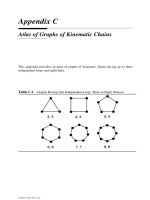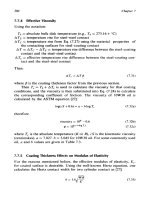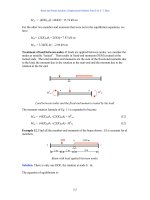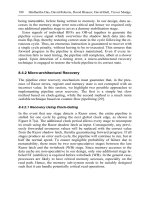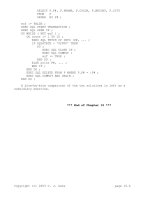ARNOLD, K. (1999). Design of Gas-Handling Systems and Facilities (2nd ed.) Episode 2 Part 3 potx
Bạn đang xem bản rút gọn của tài liệu. Xem và tải ngay bản đầy đủ của tài liệu tại đây (1.73 MB, 25 trang )
CHAPTER
11
Reciprocating
Compressors
*
The
previous section discussed
the
various types
of
compressors, their
selection,
and
process
flow.
This chapter presents greater detail
concern-
ing
the
major
components, performance, operational
and
installation con-
siderations,
and
standard specifications
for
reciprocating compressors.
For
normal production facilities, reciprocating compressors
far
out-
number
the
other types,
and it is
necessary
for the
facility
engineer
to
understand
the
details
of
reciprocating compressor design.
In
very large
horsepower ranges
or
booster compressor situations,
centrifugal
com-
pressors
are
common. These
are not
discussed
in
more
detail
in
this
book, because these large installations
are
normally
the
responsibility
of
rotating
machinery experts.
COMPONENTS
Figure
11-1
is a
cutaway
that
shows
the
various components
of a
recip-
rocating
compressor.
To
understand
how to
specify
and
maintain
a
com-
pressor
properly,
it is
necessary
to
have
a
better understanding
of the
con-
struction
of the
major
components.
*Reviewed
for the
1999
edition
by
Lonnie
W.
Shelton
of
Paragon Engineering
Services,
Inc.
286
Reciprocating Compressors
28F
Figure
11-1.
Cutaway view
of
typical
reciprocating
compressor.
Frame
The
compressor
frame,
shown
in
Figure
11-2,
is a
heavy,
ragged
cast-
ing
containing
all the
rotating parts
and on
which
the
cylinders
and
crossheads
are
mounted.
All
frames
are
rated
by the
compressor
rnanu-
Figure
11-2.
The
compressor
frame
is the
rugged
casting
that
contains
the
rotating
parts
and on
which
the
cylinders
and
crossheads
are
mounted.
(Courtesy
of
Dresser-Rand
Company.)
288
Design
of
GAS-HANDLING
Systems
and
Facilities
facturers
for a
maximum continuous horsepower, speed
(rpm),
and rod
load.
The
rated horsepower
is
determined
by the
maximum horsepower
that
can be
transmitted
through
the
crankshaft
to the
compressor
cylin-
ders.
The rod
load
is the
force imposed
on the
piston
rod by the
pressure
differential
between
the two
ends
of the
piston.
Each
frame
is
designed
for a
maximum number
of
cylinders.
The
frame
itself does
not
indicate
the
number
of
stages
or the
duty
of the
compressor.
An
individual frame
can be
used
for
many
different
sizes
of
compressor cylinders
and for a
wide range
of
applications. Frames
are
typically
classified
as
separable (balanced-opposed)
or
integral-type,
as
shown
in
Figure
11-3.
Separable (balanced-opposed)
frames
are
characterized
by an
adjacent
pair
of
crank throws
180°
out of
phase.
The frame is
separate
from
the
Figure
11-3.
Separable
(balanced-opposed)
compressor
(top)
and
integral-type
gas
engine
compressor (bottom).
Reciprocating
Compressors
289
driver.
Integral-type frames
are
characterized
by
having
compressor
cylinders
and
power cylinders mounted
on the
same
frame
and
driven
by
the
same
crankshaft.
Cylinder
A
cylinder
is a
pressure
vessel
that holds
the gas
during
the
compres-
sion
cycle. There
are two
basic types:
1.
Single-acting cylinders
are
those where compression occurs
only
once
per
crankshaft revolution,
2.
Double-acting
cylinders
are
those
where compression occurs twice
per
cranksheet revolution.
Figure
11-4
is a
cut-away drawing
of a
compressor
with single-acting
cylinders. True single-acting cylinders
are
typical
of low
horsepower
air
compressors. Single-acting process compressors
are
typically
double-act-
Figure
11-4.
Single
acting
cylinders.
(Courtesy
of
Dresser-Rand.)
290
Design
of
GAS-HANDLING
Systems
and
Facilities
Figure
11-5.
Typical
double-acting
compressor
cylinder.
(Courtesy
of
Dresser-Rand
Company.}
ing
cylinders with
the
outer
end
suction valves removed. Figure
11-5
is a
cut-away
of a
double-acting cylinder.
Cylinders
are
made
of
different
kinds
of
materials. Generally, cast
iron
is
used
for
cylinder operating pressures
up to
1,000
to
1,200 psig, nodu-
lar
iron
or
cast steel
for
operating pressure
in the
1,000
to
2,500-psig
range,
and
forged steel
for
pressures
greater
than
2,500
psig.
Like
all
pressure vessels,
the
cylinder
has a
maximum allowable work-
ing
pressure
(MAWP).
The
maximum allowable working pressure
of the
cylinder
determines
the
setting
of the
relief valve that
is
downstream
of
the
cylinder.
The
MAWP
of the
cylinder should
be a
minimum
of
10%
or
50 psi
greater than
its
operating pressure.
Reciprocating Compressors
291
Figure
11
-6.
Cut-away view showing
cylinder
liner.
(Courtesy
of
Dresser-Rand
Company.}
A
cylinder liner such
as
that shown
in
Figure
11-6
may be
used
to
help
prolong
the
life
of the
cylinder
and
improve
operating
flexibility.
Any
damage caused
by the
action
of the
piston
or
heat generated
by
compres-
sion
will
affect
the
cylinder liner, which
may be
removed
and
replaced.
As
the
surface
of the
liner wears,
it is
much
easier
and
quicker
to
repair
it
than
to
repair
the
cylinder itself.
In
addition, liners enable
the
diameter
of
the
piston
to be
varied without changing
the
cylinder
and
thus provide
flexibility to
respond
to
different
conditions
of
pressure
and flow
rate.
The
disadvantages
of
liners
are
that they increase
the
clearance
(dis-
cussed
in
more detail below)
by
increasing
the
distance between
the
pis-
ton
and the
valve,
and
they
decrease
the
bore
of the
cylinder. Therefore,
the
cylinder will have less capacity
and
lower
efficiency
(at
high ratios)
than
if
there were
no
liner.
Special
Compressor
Cylinder
Construction
Many
variations
and
combinations
of
cylinder types
and
arrangements
are
available
from
the
compressor manufacturers.
The
compressor manu-
facturer
will generally make
its
selection based
on the
most economical
combination
it has
available.
Figure
11
-7.
Steeple
cylinder.
(Courtesy
of
Dresser-Rand
Company.)
Reciprocating
Compressors
293
Figure
11-7
is a
cut-away
of a
steeple cylinder. This
cylinder
design
is
actually
two
single-acting cylinders
coupled
together with different-size
pistons
on the
same piston rod. This arrangement allows
two
stages
of
compression
on the
same compressor throw
and is
usually used
in low
capacity,
low rod
load
applications.
Another
variation
is the
tandem cylinder.
The
tandem cylinder
arrangement again allows
two
stages
of
compression
on the
same com-
pressor throw
but
uses
two
double-acting cylinders separated
by a
second
distance
piece. This arrangement
is
usually used
in low rod
load applica-
tions where higher capacity
is
required.
Figure
11-8
is a
cut-away
of the
latest innovation
in
compressor cylin-
der
design.
In
this design,
the two
suction valves
and the two
discharge
valves
are
installed inside
the
compressor cylinder bore.
The
suction
valves
are
stationary
and
located
at
each
end of the
cylinder.
The
dis-
charge valves
are
connected
to the
piston
rod to
form
the
piston; thus
the
name
valve-in-piston
design. This design
offers
the
advantages
of
lower
clearances (thus higher
efficiencies),
reduced sources
of
fugitive
emis-
sions,
fewer
replacement parts,
simpler
maintenance
procedures,
and
reduced
weight.
Distance
Pieces
A
distance piece provides
the
separation
of the
compressor cylinder
from
the
compressor
frame
as
shown
in
Figure
11-9.
At the top of the
fig-
ure
is a
standard distance
piece.
The
piston
rod
moves back
and
forth
through packing
that
is
contained
within
the
distance
piece.
The
packing keeps
the
compressed
gas
from
leaking
out of the
cylinder through
the
piston
rod
opening.
As the rod
passes through
the
packing
it is
lubricated.
As it
goes
back
and
forth,
the
rod is in
contact with
the
frame lube
oil and
with
the
cylinder lube
oil
and
gas. Thus,
oil
carry-over
may
occur
on the rod
from
the
cylinder
to
the
crankcase.
Impurities picked
up by the oil
from
the gas
being com-
pressed could contaminate crankcase oil.
In
a
single-compartment distance piece,
the
frame
end and the
cylinder
end
contain packing.
The
space
between
the
cylinder
packing
and the
frame
diaphragm
and
packing
is
sufficiently
long
to
assure that
no
part
of
the
rod
enters both
the
cylinder
and the
frame.
This minimizes contami-
nation between
the gas
being
compressed
and the oil
that
is
used
to
lubri-
cate
the
crankcase. There
are
drains
and
vents
off the
distance piece
and
off
the
packing,
so if
there
is a
packing failure,
the
high-pressure
gas has
294
Design
of
GAS-HANDLING
Systems
and
Facilities
Figure
11-8.
Valve-in-piston
double-acting
compressor
cylinder,
(Courtesy
of
Dresser-Rand
Company.)
a
place
to
vent
and not
build
up
pressure that could leak through
the
frame
packing into
the
crankcase.
An oil
slinger
as
shown
in
Figure
11
-9
may
be
added
to
further reduce
the
amount
of
cylinder lube
oil
migrating
down
the rod
into
the
crankcase.
A
two-compartment distance piece
may be
used
for
toxic gases,
but it
is
not
very
common.
In
this configuration,
no
part
of the rod
enters both
the
crankcase
and the
compartment adjacent
to the
compressor cylinder.
That
is,
even
if
there were
one
failure,
the
crankcase
oil
cannot
be
conta-
minated
with
the
toxic
gas.
Crosshead,
Rods,
and
Crankshaft
The
crosshead converts
the
rotating motion
of the
connecting
rod to a
linear, reciprocating motion, which drives
the
piston
as
shown
in
Figure
11-10.
The
crosshead
is
provided with
top and
bottom guide shoes, which
ride
on
lubricated bearing surfaces atached
to he
compressor frame.
In
addition,
balance
weights
may be
attached
to the
crosshead
to
reduce
unbalanced
forces
and
moments.
The
connecting
rod
connects
the
crank-
shaft
to the
crosshead.
The
piston
rod
connects
the
crosshead
to the
piston.
The
crankshaft rotates about
the
frame
axis, driving
the
connecting
rod,
crosshead, piston
rod,
and
piston.
Reciprocating
Compressors
295
Figure
11-9.
API
type distance pieces.
(Reprinted
with
permission from
API,
Std.
618,
3rd
Ed.,
Feb.
1986.)
296
Design
of
GAS-HANDLING
Systems
and
Facilities
Figure
11-10.
The
crosshead
converts
the
rotating
motion
of
the
connecting
rod to
a
linear,
reciprocating
motion,
which drives
the
piston. (Courtesy
of
Dresser-Rand
Company.)
Piston
The
piston
is
located
at the end of the
piston
rod and
acts
as a
movable
barrier
in the
compressor
cylinder.
It is
generally made
from
materials
such
as
aluminum
or
cast iron
and has a
hollow center. Small-diameter
high-pressure cylinders
may be
provided with
a
combined piston
and rod
machined
from
a
single piece
of bar
stock.
To
reduce friction
and
improve compression efficiency,
the
piston will
be
provided with segmented compression
rings as
shown
in
Figure
11
-1
i.
To
prevent piston-to-bore contact,
the
piston
may
also
be
provided
with
removable wear bands that
are in
continuous contact with
the
cylinder
wall.
The
compression
rings and
wear bands
are
replaced
at
regular inter-
vals
and
typically made
from
soft
materials such
as
brass,
Micarta,
Teflon,
and the
newer thermoplastics.
Bearings
Most
field
compressors
use
hydrodynamic
type
or
"journal"
bearings.
As
shown
in
Figure
11-12,
oil
enters into
the
bearing
from
supply holes
strategically placed along
the
bearing circumference
and
builds
up an oil
Reciprocating
Compressors
297
Figure
11-11.
Piston
rings
and
wear
bands
are
made
of
material
that
is
softer
than
the
cylinder
wall
with
which
they
are in
constant
contact,
so
they
must
be
replaced
regularly.
(Courtesy
of
Dresser-Rand
Company.}
Figure
11-12.
Journal bearings allow
axial
and
circumferential
oil flow
abng
the
bearing.
298
Design
of
GAS-HANDLING
Systems
and
Facilities
film
between
the
stationary
and
rotating parts
of the
bearing.
The oil
flows
axially
and
circumferentially
along
the
bearing, then
out the
ends,
As
the oil flows
through
the
bearing,
the
load compresses
the oil
film,
generating
the
high pressure within
the
bearing
that supports
the
load
while
allowing
for
rotation.
In
a
reciprocating compressor
the
bearing locations
are:
*
Main
bearings—between
crankshaft
and
frame
*
Crank
pin
bearing—between
crankshaft
and
connecting
rod
*
Wrist
pin
bearing—between
connecting
rod and
crosshead
*
Crosshead bearing
(shoe)—underneath
the
crosshead
Packing
Packing provides
the
dynamic seal between
the
cylinder
and the
piston
rod.
It
consists
of a
series
of
Teflon
rings
mounted
in a
packing
case,
which
is
bolted
to the
cylinder.
The
piston
rod
moves
in a
reciprocating motion
through
this case. Figure
11-13
shows
a
typical packing case.
The
packing
case
is
constructed
of a
number
of
pairs
of rings, as
shown
in
Figure
11-14.
The gas
pressure
is
higher
on one
side
of
each
ring.
This compresses
the
rings
against
the
sealing area. Each pair
of
rings consists
of one
radial
Figure
11-13.
Cut-away
view
of
packing
case.
(Courtesy
of C. Lee
Cook,
a
Dover
Resources
Company.)
Reciprocating Compressors
299
Figure
11-14.
Compressor
rod
packing.
cut
ring and one
tangential
cut ring. The
radial
cut ring is
installed toward
the
cylinder (pressure) side.
Gas
flows
around
the
front
face
of the
radial
cut
ring and
then around
the
outside
of
both
rings.
Since
the ring
outside
diameter
is
greater than
the
ring inside diameter,
a
squeezing force
is
exerted
on the
rod.
This seals
the
path between
the rings and the
rod.
The
radial cuts
are
positioned
in the ring
assembly
so
that they
do not
line
up
with
the
tangential cuts. Cylinder pressure will force
the ring
assembly
against
the
packing case
lip,
thus preventing
flow
around
the rings.
The
amount
of
pressure differential
one set of rings can
withstand
is
limited. Therefore, several pairs must
be
installed
to
handle typical
field
gas
compression applications.
The
basic design
of the
packing
is
left
up
to the
manufacturer.
Lubrication
is
needed
to
reduce friction
and
provide cooling. Lubricat-
ing
oil,
which must
be
finely
filtered
to
prevent grit
from
entering
the
300
Design
of
GAS-HAN
DUNG
Systems
and
Facilities
case,
is
generally injected
in the
second ring assembly.
The
pressure dif-
ferential
moves
the oil
along
the
shaft.
A
separate cooling system
may be
required
for
high-pressure
service
(5,000
psi)
or
where
high
compression ratios
and
long packing cases
are
installed.
Compressor
Valves
The
compressor valves control
the flow of gas
into
and out of the
com-
pressor cylinder.
All
valves
are
similar
in
that
the
differential pressure
across
the
seat must
be
greater than
the
balance spring force before
gas
may
flow
through
the
valve.
The
lift
characteristics, seat area,
and flow
areas determine
the
advantages
of
each design.
In
older compressor sta-
tions,
channel valves (Figure
11-15)
were commonly used. Channel
valves
are
now
considered obsolete
and
used only
in
small
air
compressors
In
today's market, there
are
three common types
of
valves—poppet
valves
(Figure
11-16),
ring valves (Figure
11-17),
and
plate valves (Figure
11-18).
Poppet valves
are
typically used
for low
compression ratio
applica-
tions,
such
as
pipeline
booster
compressors.
As the
pressure
differential
increases
across each
of the
individual poppets, they
lift
and
allow
gas to
pass
through
the flow
openings
in the
stop plate.
Ring
valves
are
typically used
for
slow speed, high pressure process
compressors. Instead
of
individual poppets, these valves
use
concentric
rings,
which open
and
close
the
valve ports.
Plate
valves
are
typically used
for
high speed separable compressors.
Plate
valves
are
similar
to
ring valves with
the
rings connected
by ribs.
Instead
of
individual elements opening
and
closing,
all
valve ports open
and
close
at the
same time.
Valve
type
and
size
should
be
specified
by the
compressor
manufactur-
er.
Normally,
the
manufacturer
will
quote
a
valve velocity, which
can be
calculated
from:
where
V =
average
gas
velocity,
ft/min
D
=
cylinder displacement,
ft
3
/min
A
=
product
of the
actual
lift,
the
valve opening periphery,
and
the
number
of
inlet
or
discharge valves
per
cylinder,
in.
2
At
lower velocities
the
valve
has
less pressure drop
and
thus
has
less
maintenance
associated with
it.
Velocities calculated
from
this equation
can
be
used
to
compare valve designs.
Reciprocating
Compressors
301
Figure
11-15.
Channel
valves.
(Courtesy
of
Ingersoll-Rand
Company.)
In
addition
to
valve velocity,
the
manufacturer
can
furnish
the
effective
flow
area
of the
valve. This area
is
determined
by
measuring
the
pressure
drop
across
the
valve with
a
known
flow
rate
and
then calculating
an
equivalent orifice area that provides
the
same pressure drop. Valves
with
larger effective
flow
areas have
less
pressure drop
and
better efficiencies,
The
effects
of the
seat
area,
the
lift
area,
and the flow
paths
are
automati-
302
Design
of
GAS-HANDLING
Systems
and
Facilities
Figyre
11-16.
Cut-away
view
of
poppet
valve.
{Courtesy
of
0resser-Roncf
Company,)
cally
included when
the
effective
flow
area
is
used
to
compare
compres-
sor
valves. This
in
turn provides
a
better comparison
of
valve
perfor-
mance than just looking
at
valve velocity.
In
addition
to
valve
efficiency,
the following
should
be
considered
in
valve
selection: ease
of
maintenance, durability,
and
spare parts required.
Capacity
Control
Devices
Reciprocating compressor capacity
may
easily
be
adjusted
by
chang-
ing
compressor speed, changing compressor cylinder clearance, unload-
ing
compressor cylinder inlet valves, recycling
gas
from
unit discharge
to
unit
suction,
or a
combination
of
these methods.
All
these methods
may
be
accomplished either manually
by the
operator
or
automatically
by the
control
panel.
The
use of
speed control
and/or
a
recycle valve
is
covered
in
Chapter
10.
Our
discussion
in
this chapter will concentrate
on
cylinder inlet valve
unloaders
and
changing cylinder clearance.
Reciprocating
Compressors
303
Figure
11-17.
Cut-away
view
of
ring
valve.
(Courtesy
of
Dresser-Rand
Company.)
Valve
Unloaders
Inlet
valve
unloaders
are
used
to
deactivate
a
cylinder
end and
reduce
its
capacity
to
zero.
Two of the
more common types
of
unloaders
are
depressor-type unloaders
and
plug-type unloaders.
Depressor-type
unloaders hold
the
inlet valve open during both
the
suction
and
discharge
304
Design
of
GAS-HANDLING
Systems
and
Facilities
Figure
11-18.
Cut*away
view
of
plate
valve.
(Courtesy
of
Dresser-tend
Company.}
strokes
so
that
all
the gas is
pushed back through
the
inlet valves
on the
discharge stroke. Plug-type
unloaders
open
a
port
to
bypass
the
iniel
valve
and
connect
the
cylinder
bore
directly with
the
inlet
gas
passage.
Compressors
may be set up
with inlet valve unloaders
to be
used
for
both capacity control
and
reducing
the
compression load during starting
and
up-set
conditions.
For
example,
the
capacity
of a
single stage com-
pressor with
two
compressor cylinders
may be
reduced
by 25% by
unloading
the
outer
end of one
cylinder
and by
another
25% by
unload-
ing
the
outer
end of the
second cylinder. Unloading
the
frame ends
of the
cylinders
at the
same time that
the
outer ends
are
unloaded will reduce
the flow to
zero
and is
recommended only
for
start-up
due to
excessive
heat
build-up inside
the
cylinder after extended operation.
The
compressor manufacturer must
be
consulted
if the
cylinder
is to
be
run
single acting with
the
frame
end
unloaded. Many times
rod
load
reversal
and
proper
lubrication
may not be
achieved while running single
acting with
the
frame
end
unloaded.
When
a
cylinder
end is
deactivated,
the
pulsation
levels
in the
piping
system
can
increase significantly.
If a
cylinder
may be
operated
with
Reciprocating
Compressors
305
unloaders,
it
needs
to be
analoged
in
both
its
operating mode
and its
unloaded
mode,
Cylinder
Clearance
Clearance
is the
volume remaining
in a
cylinder
end
when
the
piston
is
at
the end of its
stroke. This
is the sum of the
volume between
the
head
of
the
cylinder
and the
piston,
and the
volume under
the
valve seats.
The
total clearance
is
expressed
in
percent
of the
total piston displacement,
normally
between
4 and
30%.
As
the
piston starts
its
suction stroke,
the gas
that remains
in the
cylin-
der in the
fixed
and
added clearance
areas
expands
until
the
pressure
in
the
cylinder
is
equal
to the
pressure
in the
line
outside
of the
cylinder.
The
greater
the
clearance,
the
longer
it
takes
for the
suction valves
to
open
and the
less
new gas
enters
the
cylinder. Therefore, less
gas
will
be
compressed
as
cylinder clearance
is
increased.
End
clearance
is
required
to
keep
the
piston
from
striking
the
compres-
sor
head
or
crank
end.
Some small clearance
is
also required under
suc-
Figure
11-19,
Fixed volume
clearance
pocket.
(Courtesy
of
Dresser-Rand
Company.)
306
Design
of
GAS-HANDLING
Systems
and
Facilities
tlon
and
discharge valves
so
that
the
valves
can be
removed
and
rein-
stalled.
These clearances
are
called
fixed
clearances
and can be
adjusted
by:
»
Removing
a
small portion
of the end of the
compressor piston
*
Shortening
the
projection
of the
cylinder heads into
the
cylinder
*
Installing spacer rings between cylinder head
and
body
or
under
the
valves
Variable
clearance that
can be
changed very readily
can be
built
into
the
cylinder.
Figure
11-19
is an
example
of a
fixed volume clearance
mounted
on the
cylinder. This type
is
separated
from
the
cylinder
by
a
valve that
can be
opened
and
closed
from
the
outside.
Fixed clearance
can
also
be
added
to the
outer
end of the
cylinder
by
adding
a
fabricated clearance bottle with
the
desired
volume.
To
change
the
performance
of the
cylinder
the
clearance
can be
changed
by
shutting
down
the
compressor,
unbolting
one
bottle,
and
installing another bottle
with
a
different
volume.
It is
very easy
in
that respect
to add
clearance
and
subtract clearance from
a
cylinder
if the
cylinder
is set up to
receive
clearance
bottles.
Figure
11-20.
Variable
volume
clearance
pocket.
(Courtesy
of
Dresser-Rand
Company.}
Reciprocating
Compressors
307
More
flexibility
can be
obtained with
a
variable volume clearance
such
as
that shown
in
Figure
11
-20. This
is a
plug built into
the
outer
cylinder head. When moved,
the
clearance volume
of the
outer
end
of
the
cylinder
changes.
Clearance
is
normally expressed
as a
percent
or
fraction
of
cylinder
displacement.
It is
given
by:
Single
acting
cylinder (head
end
clearance)
Double
acting
cylinder (average clearance)
where
% C =
cylinder
clearance,
fraction
d
c
=
cylinder diameter,
in.
d
r
= rod
diameter,
in.
C
HE
=
head
end
clearance,
in
3
C
CE
=
crank
end
clearance,
in
3
s =
stroke length,
in.
Note:
C
HE
an
d
C
CE
can be
obtained
from the
manufacturer.
CYLINDER
SIZING
Typically,
in
specifying
a
unit,
the
suction
and
discharge pressures, capac-
ity
(MMscfd),
inlet temperature,
and gas
properties
are
given.
The
actual siz-
ing
of the
cylinders
is
left
to the
manufacturer
from
his
specific combina-
tions
of
standard cylinders, pistons,
and
liners. However, once
a
proposal
is
received
from
a
manufacturer, sometimes
it is
beneficial
to
check
the
cylin-
der
sizing
and
make sure that indeed
the
compressor will perform. Some-
times
it is
necessary
to
size
a new
cylinder
for an
existing compressor
or to
verify
that
an
existing compressor will perform
in a
different
service.
The
capacity
of the
cylinder
is a
function
of
piston displacement
and
volumetric
efficiency.
This
is in
turn
a
function
of
cylinder clearance,
compression
ratio,
and gas
properties.
308
Design
of
GAS-HANDLING
Systems
and
Facilities
Piston
Displacement
The
actual
volume
of the
cylinder that
is
swept
by the
piston
per
minute
is
piston displacement.
It can be
calculated
from:
Single
acting cylinder (head
end
displacement)
Single
acting cylinder (crank
end
displacement)
where
PD =
piston displacement,
cfm
s =
stroke length,
in.
rpm
=
compressor speed,
rpm
d
c
=
diameter
of
cylinder,
in.
d,
=
diameter
of
rod,
in.
Double acting cylinder (sum
of
head
end and
crank
end
displacement)
Throughput
can be
changed directly
by
changing
the
piston displace-
ment.
This
can be
accomplished
by
changing
the
speed,
by
removing
or
deactivating suction valves,
or by
converting
a
double acting cylinder
to
single
acting.
In
addition, piston
displacement
and
thus throughput
can be
changed
by
changing cylinder liners, installing sleeves,
or
boring
the
cylinder,
Volumetric
Efficiency
The flow
rate
is not
directly equal
to the
piston displacement.
Volu-
metric efficiency
is the
ratio
of
actual volumetric
flow at
inlet
tempera-
ture
and
pressure conditions
to
piston displacement.
It is
given
by:
Reciprocating
Compressors
309
where
E
v
=
stage volumetric
efficiency,
%
R
=
compression ratio
(P<j/P
s
)
of the
compressor stage (based
on
absolute pressure)
C
=
cylinder
clearance,
percent
of
piston displacement
Z
s
=
compressibility factor
at
suction, psia
Z
d
=
compressibility factor
at
discharge, psia
k
=
ratio
of
specific heats,
C
p
/C
v
It
can be
seen
from
Equation
11-7
that
as R is
increased,
and as
clearance
is
increased, volumetric
efficiency
is
reduced.
The
relationship
of
volumet-
ric
efficiency
and
clearance
is
important, because
it
allows variable clear-
ances (both
fixed
volume
and
adjustable volume pockets)
to be
used
to
con-
trol
capacity
and
obtain
the
maximum
use of
available driver horsepower.
Cylinder
Throughput
Capacity
Using
a
known
piston
displacement
and
efficiency,
the gas
throughput
can be
calculated
from:
where
q
a
= gas
throughput
at
suction conditions
of
temperature
and
pressure,
ft
3
/min
E
v
=
volumetric
efficiency
PD =
piston displacement,
fVVmin
or
from:
where
q
g
= gas
throughput
at
standard conditions,
scfm
P
s
=
suction pressure, psia
T
s
=
suction temperature,
°R
Z
s
=
compressibility
at
suction conditions
or
from:
where
Q
g
= gas
throughput, MMscfd
310
Design
of
GAS-HANDLING
Systems
and
Facilities
Compressor
Flexibility
To
enhance compressor
flexibility
it is
desirable
to
design into
the
compressor
the
capability
of
operating
at
other than
the
original design
conditions.
If it is
desired
to
provide
flexibility
to
operate
at
lower
suc-
tion
pressures:
*
Add the
ability
to
increase speed
or
*
Add
variable clearance
initially,
when
the
suction pressure
is
high;
at
lower suction pressure clearance
is
removed
to
increase actual
throughput.
To
provide
flexibility for an
eventually higher suction temperature:
«Add
the
ability
to
increase speed
or
*
Add
variable clearance
to
reduce capacity initially
at low
temperature;
at
high temperature clearance
is
removed
to
increase actual throughput.
To
provide
flexibility for
eventually higher discharge pressures:
*
Ensure there
are
enough stages
at the
outset
so
that
the
ratio
per
stage
can
increase
and
still
keep
within
the
discharge
temperature limits
or
*
Use
variable clearance
to
adjust
ratio
per
stage.
To
provide
flexibility for
increased throughput:
*
Add
the
ability
to
increase speed
or
*
Add
variable clearance
to
reduce capacity initially when
the
through-
put
is
low; clearance
is
removed
to
increase throughput.
ROD
LOAD
The
allowable
rod
load depends
on rod
diameter
and
material,
and
will
be
quoted
by the
manufacturer.
The
actual load
can be
calculated
from
the
following
equations
if the
geometry
is
known:
Single-acting cylinder, head
end



